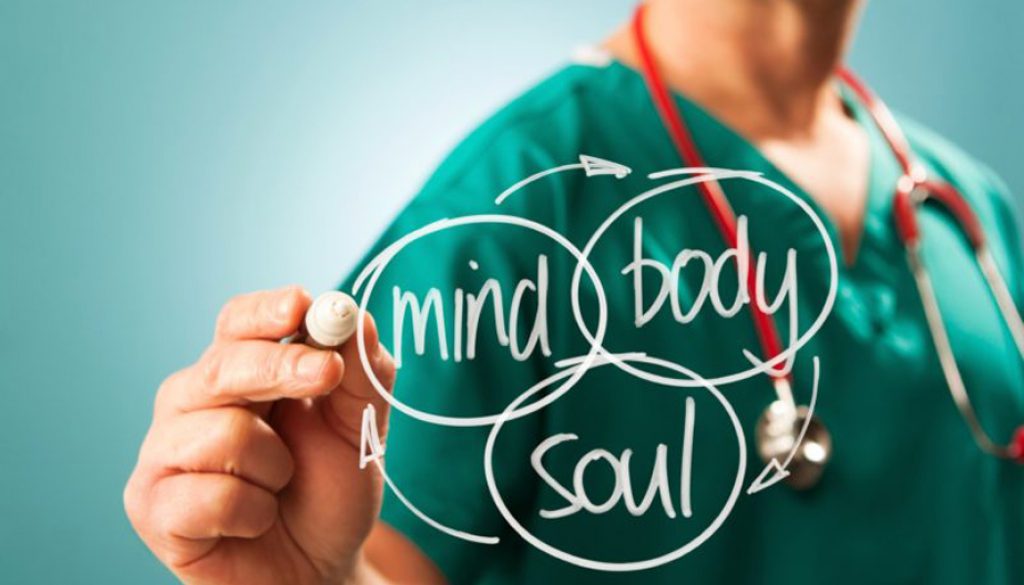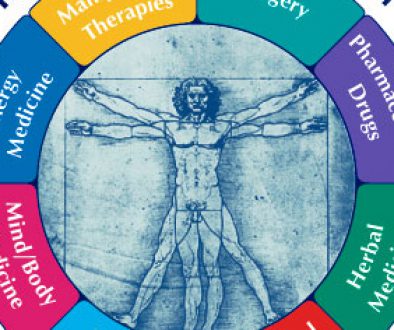Modalities of Integrative Holistic Medicine
Integrative Holistic Modalities
 Acupressure : Strictly speaking, acupressure is a form of acupuncture, but instead of inserting fine needles into specific points on the body, acupressure uses manual pressure on the points to achieve the same results. Although complications from acupuncture are extremely rare, infection is a possibility if needles are reused and improperly sterilized. Acupressure, however, carries no risk from infection because no needles are used. Acupressure has many other benefits as well: It can be easily taught and, therefore, self-administered.
Acupressure : Strictly speaking, acupressure is a form of acupuncture, but instead of inserting fine needles into specific points on the body, acupressure uses manual pressure on the points to achieve the same results. Although complications from acupuncture are extremely rare, infection is a possibility if needles are reused and improperly sterilized. Acupressure, however, carries no risk from infection because no needles are used. Acupressure has many other benefits as well: It can be easily taught and, therefore, self-administered.
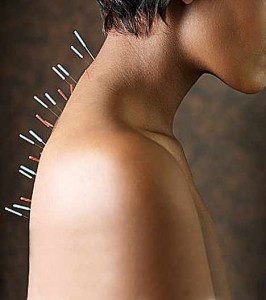 Acupuncture: A technique of inserting fine needles into certain points in the body as a treatment for different health conditions. Acupuncture has been used in China for thousands of years and in Western Europe for several hundred years. Acupuncture came to America in the late 1800s when Sir William Osler’s Principles and Practice of Medicine – an early American medical textbook, first published in 1892 – recommended acupuncture for the treatment of lumbago, or lower-back pain.
Acupuncture: A technique of inserting fine needles into certain points in the body as a treatment for different health conditions. Acupuncture has been used in China for thousands of years and in Western Europe for several hundred years. Acupuncture came to America in the late 1800s when Sir William Osler’s Principles and Practice of Medicine – an early American medical textbook, first published in 1892 – recommended acupuncture for the treatment of lumbago, or lower-back pain.
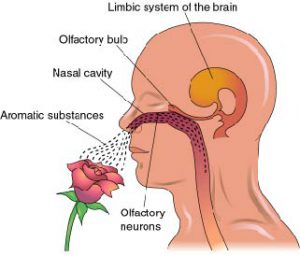 Aromatherapy: Aromatherapy is a gentle, non-toxic, pleasant, yet powerful tool for healing. It is based on the healing properties of essential oils extracted from flowers, grass, barks and herbs, which are applied topically, diffused into the air, or otherwise used therapeutically. Aromatherapy is versatile as it can be used to relieve mental and emotional complaints as well as physical ailments.
Aromatherapy: Aromatherapy is a gentle, non-toxic, pleasant, yet powerful tool for healing. It is based on the healing properties of essential oils extracted from flowers, grass, barks and herbs, which are applied topically, diffused into the air, or otherwise used therapeutically. Aromatherapy is versatile as it can be used to relieve mental and emotional complaints as well as physical ailments.
 Bioenergetics :Bioenergetics is the practice of unlocking energy through exercises and character analysis. The exercises focus on loosening tight muscles. Often a practitioner will provide firm pressure to the blocked areas to provide release. An area of focus is the use of breathing to facilitate opening the body energy. This form of therapy was founded in the 1950s and was developed from Reichian therapy.
Bioenergetics :Bioenergetics is the practice of unlocking energy through exercises and character analysis. The exercises focus on loosening tight muscles. Often a practitioner will provide firm pressure to the blocked areas to provide release. An area of focus is the use of breathing to facilitate opening the body energy. This form of therapy was founded in the 1950s and was developed from Reichian therapy.
 Biofeedback : Biofeedback therapy uses monitoring equipment to “feed back” to people physiologic information of which they are not normally aware. By watching the monitoring device, individuals can learn to adjust their thinking and other mental patterns to control body processes such as blood pressure, brain-wave activity, muscle contraction and relaxation, gastrointestinal functioning, and body temperature.
Biofeedback : Biofeedback therapy uses monitoring equipment to “feed back” to people physiologic information of which they are not normally aware. By watching the monitoring device, individuals can learn to adjust their thinking and other mental patterns to control body processes such as blood pressure, brain-wave activity, muscle contraction and relaxation, gastrointestinal functioning, and body temperature.
 Body Psychotherapy: Body Psychotherapy recognizes the deep connections to which all mind-body processes contribute in equal fashion to the personality, problems, issues, behaviors, reactions, choices, and general well-being of the person. There is now a hierarchal relationship between mind and body, between psyche and soma: They are both functioning as interactive aspects of the whole. Body Psychotherapy is particularly helpful in working with the effects of emotional pain, trauma and abuse, and explores the limiting of belief systems and habitual/automatic attitudes, both physical and psychological. In so doing, it works to bring our unconscious “reality” into consciousness where it can be addressed and transformed.
Body Psychotherapy: Body Psychotherapy recognizes the deep connections to which all mind-body processes contribute in equal fashion to the personality, problems, issues, behaviors, reactions, choices, and general well-being of the person. There is now a hierarchal relationship between mind and body, between psyche and soma: They are both functioning as interactive aspects of the whole. Body Psychotherapy is particularly helpful in working with the effects of emotional pain, trauma and abuse, and explores the limiting of belief systems and habitual/automatic attitudes, both physical and psychological. In so doing, it works to bring our unconscious “reality” into consciousness where it can be addressed and transformed.
 Body Work: Bodywork is a general term that covers many manual and manipulative healing modalities, such as acupressure, bioenergetic therapy, craniosacral therapy, kinesiology, massage, movement therapies, myotherapy, polarity therapy, yoga therapy, and others. All bodywork therapies involve manipulative techniques aimed at restoring the body to its optimum condition, thereby encouraging the proper functioning of all body systems. They are holistic modalities that focus on the cause of health problems and treat all aspects of the person, including the body, mind and spirit, rather than the symptoms alone.
Body Work: Bodywork is a general term that covers many manual and manipulative healing modalities, such as acupressure, bioenergetic therapy, craniosacral therapy, kinesiology, massage, movement therapies, myotherapy, polarity therapy, yoga therapy, and others. All bodywork therapies involve manipulative techniques aimed at restoring the body to its optimum condition, thereby encouraging the proper functioning of all body systems. They are holistic modalities that focus on the cause of health problems and treat all aspects of the person, including the body, mind and spirit, rather than the symptoms alone.
 Breath work: Western mind-body scientists and consciousness researchers have recently rediscovered the breath. Directed breathing patterns have been a vital feature of many Eastern philosophies for centuries. In western-based systems of education, the potential role of the breath as anything more sophisticated than being the basis for respiration and survival has been grossly overlooked. Despite findings which indicate that the mind-body system is healthiest when the breath is unrestricted, there is little information made available to the general public about the importance of full and natural respiration. Shallow and constricted breathing – a condition of the vast majority of people – has been linked to a battery of physical and emotional disorders as well as psychosomatic symptoms. Full Wave Breath work can alter and improve not only our physical condition, but also our emotional and mental states. This is not something the intellect learns. Rather, it is a new habit that the body is taught.
Breath work: Western mind-body scientists and consciousness researchers have recently rediscovered the breath. Directed breathing patterns have been a vital feature of many Eastern philosophies for centuries. In western-based systems of education, the potential role of the breath as anything more sophisticated than being the basis for respiration and survival has been grossly overlooked. Despite findings which indicate that the mind-body system is healthiest when the breath is unrestricted, there is little information made available to the general public about the importance of full and natural respiration. Shallow and constricted breathing – a condition of the vast majority of people – has been linked to a battery of physical and emotional disorders as well as psychosomatic symptoms. Full Wave Breath work can alter and improve not only our physical condition, but also our emotional and mental states. This is not something the intellect learns. Rather, it is a new habit that the body is taught.
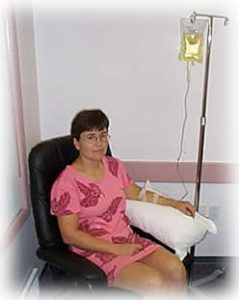 Chelation Therapy: Chelation therapy is the most commonly used conventional treatment for lead and other toxic metal poisoning. It is an increasingly popular alternative therapy for the treatment of cardiovascular disease, particularly atherosclerosis, and other chronic degenerative conditions. It is available in an oral or intravenous form and works by introducing an agent into the body which binds to toxic metals and carries them out of the body via the bladder.
Chelation Therapy: Chelation therapy is the most commonly used conventional treatment for lead and other toxic metal poisoning. It is an increasingly popular alternative therapy for the treatment of cardiovascular disease, particularly atherosclerosis, and other chronic degenerative conditions. It is available in an oral or intravenous form and works by introducing an agent into the body which binds to toxic metals and carries them out of the body via the bladder.
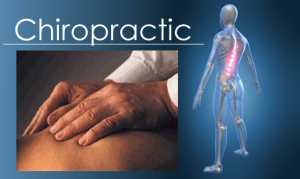 Chiropractic : Chiropractors operate on the theory that the improper alignment of the vertebrae (the bones that make up the spinal column) and the spinal cord they protect, is the cause of diseases and disorders. Chiropractors apply pressure in a specific manner to allow the body to realign the vertebrae in the spinal column.
Chiropractic : Chiropractors operate on the theory that the improper alignment of the vertebrae (the bones that make up the spinal column) and the spinal cord they protect, is the cause of diseases and disorders. Chiropractors apply pressure in a specific manner to allow the body to realign the vertebrae in the spinal column.
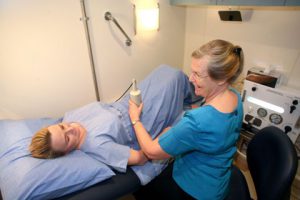 Colon Therapy : Colon therapy (also called colon hydrotherapy or colon irrigation) cleanses and detoxifies the large intestine by irrigating it with purified water. Vitamins, herbs, helpful bacteria, or oxygen also may be added to the water.
Colon Therapy : Colon therapy (also called colon hydrotherapy or colon irrigation) cleanses and detoxifies the large intestine by irrigating it with purified water. Vitamins, herbs, helpful bacteria, or oxygen also may be added to the water.
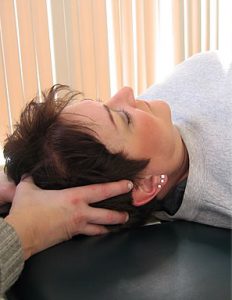 Craniosacral Therapy: Just as the heartbeat signals the body’s cardiac rhythm and breathing indicates respiratory rhythm, the functioning of the craniosacral system – the head and spine – creates the craniosacral rhythm. Craniosacral therapy monitors this rhythm and uses gentle, hands-on manipulations to correct abnormalities and enhance well-being.
Craniosacral Therapy: Just as the heartbeat signals the body’s cardiac rhythm and breathing indicates respiratory rhythm, the functioning of the craniosacral system – the head and spine – creates the craniosacral rhythm. Craniosacral therapy monitors this rhythm and uses gentle, hands-on manipulations to correct abnormalities and enhance well-being.
 Detoxification and Fasting : We live in an increasingly polluted world. Our bodies have become storehouses for pesticide residues, heavy metals, food additives, chemical contaminants, pharmaceuticals, industrial pollutants, and other toxic substances. Detoxification, fasting, and colon therapies help us to cleanse our bodies, thus improving vitality and boosting our ability to fight many types of illness.
Detoxification and Fasting : We live in an increasingly polluted world. Our bodies have become storehouses for pesticide residues, heavy metals, food additives, chemical contaminants, pharmaceuticals, industrial pollutants, and other toxic substances. Detoxification, fasting, and colon therapies help us to cleanse our bodies, thus improving vitality and boosting our ability to fight many types of illness.
EMDR (Eye Movement Desensitization and Reprocessing) : EMDR is a procedure used in psychotherapy to help reduce the impact of traumatic events such as assault, abuse, accidents, physical illness or natural disasters. EMDR has been used effectively to help people with post-traumatic stress symptoms including anxiety, nightmares, panic attacks and grief. EMDR practice involves coordinating one’s thoughts and memories with specific and directed movement of the eyes to facilitate the “reprogramming” of emotional responses. It helps people to recognize and desensitize images, memories and feelings that arise from traumatic events in order to help them think more positively about the event and themselves.
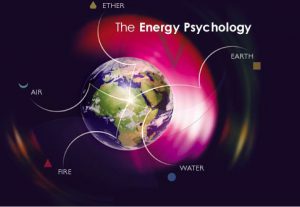 Energy Psychology : A relatively new area of psychology, Energy Psychology addresses psychological issues and psychosomatic ailments by working with the body’s subtle energies. The practitioner leads the client through tapping, touching, or rubbing certain points on the body, while tuned into a problem of mental, emotional or physical origin. This clears disturbances in the body’s energy flow and allows the client to experience healing, catharsis, and cessation of mental, emotional and often physical ailments.
Energy Psychology : A relatively new area of psychology, Energy Psychology addresses psychological issues and psychosomatic ailments by working with the body’s subtle energies. The practitioner leads the client through tapping, touching, or rubbing certain points on the body, while tuned into a problem of mental, emotional or physical origin. This clears disturbances in the body’s energy flow and allows the client to experience healing, catharsis, and cessation of mental, emotional and often physical ailments.
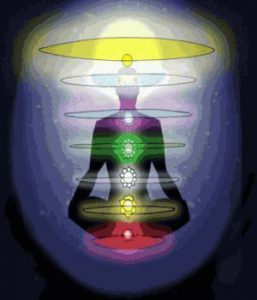 Energy Work : Energy interventions like Healing Touch, Therapeutic Touch, Reiki, Touch for Health, Qi Gong, Quantum-Touch, and others are becoming more widely used in combination with conventional medical treatment modalities. In short, these therapies recognize the subtle energies of the body and aim to either restore a person’s energetic balance, or raise such energies in order to promote healing. Some energy therapies (such as Reiki and Quantum-Touch) work on the theory that when a practitioner raises energy around of an ailing part of the body, the body’s energy entrains (or rises up, in order to match) that which the practitioner is generating. When the body’s energy rises, the body is able to heal itself.
Energy Work : Energy interventions like Healing Touch, Therapeutic Touch, Reiki, Touch for Health, Qi Gong, Quantum-Touch, and others are becoming more widely used in combination with conventional medical treatment modalities. In short, these therapies recognize the subtle energies of the body and aim to either restore a person’s energetic balance, or raise such energies in order to promote healing. Some energy therapies (such as Reiki and Quantum-Touch) work on the theory that when a practitioner raises energy around of an ailing part of the body, the body’s energy entrains (or rises up, in order to match) that which the practitioner is generating. When the body’s energy rises, the body is able to heal itself.
 Environmental Medicine: In environmental medicine, the causes of illnesses are sought in the substances that are found in the individual’s surroundings. Indeed, responses to foods, chemicals in the home and workplace, and common allergens, such as dander, dust and dust mites, molds, and pollens, are implicated in many ailments. Individual responses to these exposures vary and are specific to each person’s level of susceptibility. Illness can be the result of a large one-time exposure, or low level, gradual exposures.
Environmental Medicine: In environmental medicine, the causes of illnesses are sought in the substances that are found in the individual’s surroundings. Indeed, responses to foods, chemicals in the home and workplace, and common allergens, such as dander, dust and dust mites, molds, and pollens, are implicated in many ailments. Individual responses to these exposures vary and are specific to each person’s level of susceptibility. Illness can be the result of a large one-time exposure, or low level, gradual exposures.
 Feldenkrais : The Feldenkrais method combines movement training, gentle touch, and verbal dialogue to help people create freer, more efficient movement. Developed by the Russian-born Israeli physicist Moshe Feldenkrais, it is based on modern ideas and basic research about perception, motor learning, neural plasticity, and sensory integration.
Feldenkrais : The Feldenkrais method combines movement training, gentle touch, and verbal dialogue to help people create freer, more efficient movement. Developed by the Russian-born Israeli physicist Moshe Feldenkrais, it is based on modern ideas and basic research about perception, motor learning, neural plasticity, and sensory integration.
 Guided Imagery : Imagery is the process of imagining through any sense – hearing, sight, smell, taste, or touch. Sometimes the word imagery is used in the same way as visualization, but visualization refers only to seeing something in the mind’s eye. A practitioner guides a client through an imagery session in order to address subconscious issues, to dialogue with various or ailing parts of the body, and/ or to facilitate healing or re-patterning of mental, emotional, or physical issues.
Guided Imagery : Imagery is the process of imagining through any sense – hearing, sight, smell, taste, or touch. Sometimes the word imagery is used in the same way as visualization, but visualization refers only to seeing something in the mind’s eye. A practitioner guides a client through an imagery session in order to address subconscious issues, to dialogue with various or ailing parts of the body, and/ or to facilitate healing or re-patterning of mental, emotional, or physical issues.
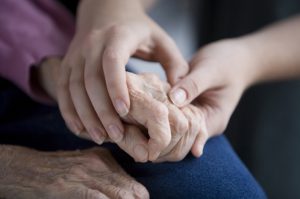 Healing Touch : The application of Healing Touch is derived by the ancient laying-on-of-hands, which has been a form of healing since early civilization. (See “Energy Work,” above.)
Healing Touch : The application of Healing Touch is derived by the ancient laying-on-of-hands, which has been a form of healing since early civilization. (See “Energy Work,” above.)
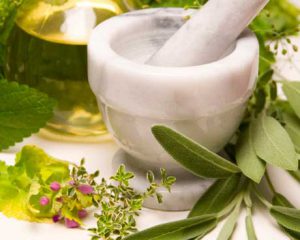 Herbal Medicine: Herbal medicine is often the first thing that comes to mind when someone mentions alternative therapies. Indeed, herbs are the basis of many different medicinal systems around the world. Especially popular in Asia, India, and Europe, herbal medicine is used by an estimated 80% of the world’s population. Modern conventional medicine owes much to its herbal past. Drug companies still use the natural plant world as a source of many of its pharmaceutical inspirations. In fact, 77% of the 150 most commonly prescribed drugs are of plant origin. More and more conventional physicians are also discovering the healing power of plants. Herbal remedies may be as simple as using ingesting a whole herb for medicinal purposes or may be prepared as teas, infusions, capsules, salves, tinctures, compresses, and decoctions.
Herbal Medicine: Herbal medicine is often the first thing that comes to mind when someone mentions alternative therapies. Indeed, herbs are the basis of many different medicinal systems around the world. Especially popular in Asia, India, and Europe, herbal medicine is used by an estimated 80% of the world’s population. Modern conventional medicine owes much to its herbal past. Drug companies still use the natural plant world as a source of many of its pharmaceutical inspirations. In fact, 77% of the 150 most commonly prescribed drugs are of plant origin. More and more conventional physicians are also discovering the healing power of plants. Herbal remedies may be as simple as using ingesting a whole herb for medicinal purposes or may be prepared as teas, infusions, capsules, salves, tinctures, compresses, and decoctions.
 Holistic Dentistry: The holistic dentist has an interdisciplinary approach to healthcare that facilitates the individual’s innate ability to heal. The holistic dentist promotes complete healing of the client. As part of this goal, the holistic dentist focuses on helping the client eliminate toxins from his or her body. Holistic dentists will remove mercury fillings and replace them with mercury-free fillings, and offer dental treatments free of fluoride. This type of dentist will emphasize nutrition and non-surgical methods to improve dental health.
Holistic Dentistry: The holistic dentist has an interdisciplinary approach to healthcare that facilitates the individual’s innate ability to heal. The holistic dentist promotes complete healing of the client. As part of this goal, the holistic dentist focuses on helping the client eliminate toxins from his or her body. Holistic dentists will remove mercury fillings and replace them with mercury-free fillings, and offer dental treatments free of fluoride. This type of dentist will emphasize nutrition and non-surgical methods to improve dental health.
 Hydrotherapy : As the name implies, hydrotherapy is therapy with water in any of its forms – ice, cold water, hot water, steam, freshwater, or water imbued with special minerals. Water can be used on or in the body to enhance health and treat a variety of health problems.
Hydrotherapy : As the name implies, hydrotherapy is therapy with water in any of its forms – ice, cold water, hot water, steam, freshwater, or water imbued with special minerals. Water can be used on or in the body to enhance health and treat a variety of health problems.
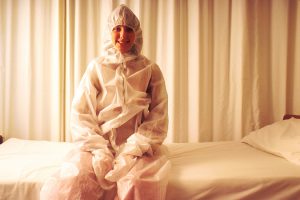 Hyperthermia Therapy : Hyperthermia is a therapy that uses one of the body’s own defense mechanisms: Fever. A fever helps to destroy invading organisms and sweat away impurities. Hyperthermia treatments range from low-tech, do-it-yourself methods, such as hot baths and saunas, to high-tech approaches that need to be administered and supervised by a trained professional.
Hyperthermia Therapy : Hyperthermia is a therapy that uses one of the body’s own defense mechanisms: Fever. A fever helps to destroy invading organisms and sweat away impurities. Hyperthermia treatments range from low-tech, do-it-yourself methods, such as hot baths and saunas, to high-tech approaches that need to be administered and supervised by a trained professional.
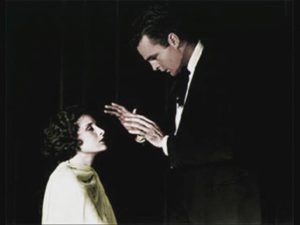 Hypnotherapy – Hypnosis : Hypnotherapy is a therapy that utilizes hypnosis – sometimes called the art of suggestion. Physical, psychological, and emotional disorders have been found to respond well to hypnotherapy. Today many medical doctors, dentists, psychologists, psychiatrists, and natural health practitioners are using hypnotherapy for conditions ranging from asthma and eating disorders to skin diseases.
Hypnotherapy – Hypnosis : Hypnotherapy is a therapy that utilizes hypnosis – sometimes called the art of suggestion. Physical, psychological, and emotional disorders have been found to respond well to hypnotherapy. Today many medical doctors, dentists, psychologists, psychiatrists, and natural health practitioners are using hypnotherapy for conditions ranging from asthma and eating disorders to skin diseases.
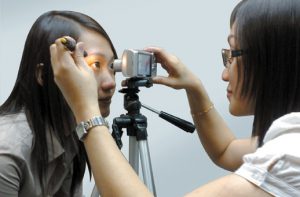 Iridology : Iridology is the practice of looking at the fiber, color, texture and pattern in the iris of the eye to determine whether a person is exhibiting any inflammation, stress or inherent weaknesses in the overall body constitution. These weaknesses can be longstanding or recent changes. A method of diagnosis rather than of treatment, iridology can be used to facilitate the prevention of illness, as practitioners can provide the client with information about familial tendencies and areas of physiological (and sometimes mental) weakness.
Iridology : Iridology is the practice of looking at the fiber, color, texture and pattern in the iris of the eye to determine whether a person is exhibiting any inflammation, stress or inherent weaknesses in the overall body constitution. These weaknesses can be longstanding or recent changes. A method of diagnosis rather than of treatment, iridology can be used to facilitate the prevention of illness, as practitioners can provide the client with information about familial tendencies and areas of physiological (and sometimes mental) weakness.
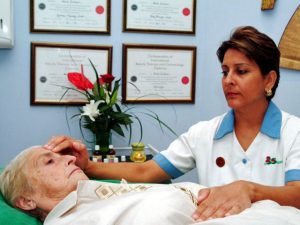 Jin Shin Jyutsu™ : An ancient art of harmonizing life energy within the body, Jin Shin Jyutsu is dynamic and powerful in its ability to restore harmony to the body, mind, emotions and spirit. This energy balancing healing technique facilitates the unlocking of stuck energy via gentle fingertip pressure on the body. This modality can be practiced on oneself or by a practitioner. It is similar in form to Reiki or pranic healing.
Jin Shin Jyutsu™ : An ancient art of harmonizing life energy within the body, Jin Shin Jyutsu is dynamic and powerful in its ability to restore harmony to the body, mind, emotions and spirit. This energy balancing healing technique facilitates the unlocking of stuck energy via gentle fingertip pressure on the body. This modality can be practiced on oneself or by a practitioner. It is similar in form to Reiki or pranic healing.
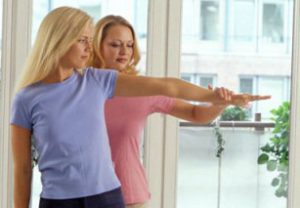 Kinesiology : Applied kinesiology, and a closely related technique called “touch for health,” use the meridian “qi” (or “vital energy”) and connections between the neurological and muscular systems to make diagnoses and provide therapy. Applied kinesiology includes its own diagnostic method of determining dysfunctional states of the body in combination with standard medical diagnostic tests.
Kinesiology : Applied kinesiology, and a closely related technique called “touch for health,” use the meridian “qi” (or “vital energy”) and connections between the neurological and muscular systems to make diagnoses and provide therapy. Applied kinesiology includes its own diagnostic method of determining dysfunctional states of the body in combination with standard medical diagnostic tests.
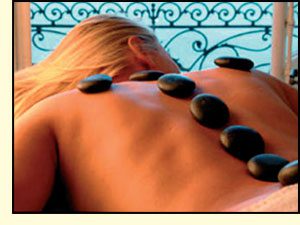 LaStone Therapy : Clinically, LaStone Therapy is the application of thermotherapy, using deep penetrating heated stones and alternating with extremely cold stones. Adjusting temperatures in bodywork to aid clients in healing has always been beneficial.
LaStone Therapy : Clinically, LaStone Therapy is the application of thermotherapy, using deep penetrating heated stones and alternating with extremely cold stones. Adjusting temperatures in bodywork to aid clients in healing has always been beneficial.
 Light & Sound Therapy (Toning), & Magnetic Therapy : Sound waves, light waves, and magnetic fields all have beneficial health effects when applied appropriately. Music therapy, for example, has been used to reduce pain and anxiety, stemming from its ability to affect physiological processes such as respiratory rate, blood pressure, and cardiac output. When light enters the eye, it triggers a cascade of nerve and endocrine (glandular) activities that ultimately influence most bodily functions, including sexual function, immunity, and sleep. Magnetic field therapy may stimulate metabolism and increase the amount of oxygen to the cells.
Light & Sound Therapy (Toning), & Magnetic Therapy : Sound waves, light waves, and magnetic fields all have beneficial health effects when applied appropriately. Music therapy, for example, has been used to reduce pain and anxiety, stemming from its ability to affect physiological processes such as respiratory rate, blood pressure, and cardiac output. When light enters the eye, it triggers a cascade of nerve and endocrine (glandular) activities that ultimately influence most bodily functions, including sexual function, immunity, and sleep. Magnetic field therapy may stimulate metabolism and increase the amount of oxygen to the cells.
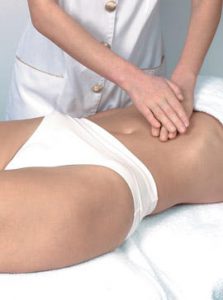 Lymph Drainage : The lymph system is responsible for the removal, cleaning, and storage of waste products and toxins in the body. Manual Lymph Drainage (MLD) was developed in Europe in the 1930s by Dr. Emil Vodder and his wife, Estred. At that time, lymph nodes were frequently removed because they were considered to be malfunctioning when swollen. This would further compromise the body’s ability to fend off infections. MLD therapy consists of a series of light, rhythmic manipulations in order to stimulate lymph flow and fluid movement.
Lymph Drainage : The lymph system is responsible for the removal, cleaning, and storage of waste products and toxins in the body. Manual Lymph Drainage (MLD) was developed in Europe in the 1930s by Dr. Emil Vodder and his wife, Estred. At that time, lymph nodes were frequently removed because they were considered to be malfunctioning when swollen. This would further compromise the body’s ability to fend off infections. MLD therapy consists of a series of light, rhythmic manipulations in order to stimulate lymph flow and fluid movement.
Massage Therapies : Massage is the use of manual techniques to achieve or increase health and well-being. Massage therapy encompasses a wide variety of techniques based on methods that have been around for thousands of years.
 Meditation: Meditation comes in diverse forms and has been shown to enhance physical, psychological, and emotional well-being. High blood pressure, pain, and anxiety disorders are but a few of the conditions that meditation can mitigate. The key to successful meditation practice is to find a technique suited to you and then practice it consistently.
Meditation: Meditation comes in diverse forms and has been shown to enhance physical, psychological, and emotional well-being. High blood pressure, pain, and anxiety disorders are but a few of the conditions that meditation can mitigate. The key to successful meditation practice is to find a technique suited to you and then practice it consistently.
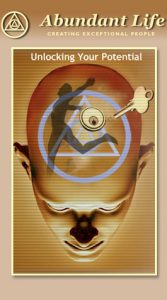 Mind-Body Medicine : The mind and the body are very closely linked. In fact, the idea that the two are separate entities at all is a relatively recent concept in human history. Maximizing their close relationship to improve overall health is what mind-body medicine is all about. A diverse group of therapies fall under the heading mind-body medicine, but they have at least one thing in common: They use the often untapped power of the mind to promote healing.
Mind-Body Medicine : The mind and the body are very closely linked. In fact, the idea that the two are separate entities at all is a relatively recent concept in human history. Maximizing their close relationship to improve overall health is what mind-body medicine is all about. A diverse group of therapies fall under the heading mind-body medicine, but they have at least one thing in common: They use the often untapped power of the mind to promote healing.
 Mitzvah Technique : The Mitzvah Technique is a reeducation and functional integration discipline, developed by M. Cohen-Nehemia, formerly of Israel, founder of The Canadian Mitzvah Technique Center and Training School. With this technique the person’s overall wellness is improved by optimizing the musculoskeletal alignment and by improving the person’s body mechanics. Functional aids such as back supports are included in this therapeutic modality.
Mitzvah Technique : The Mitzvah Technique is a reeducation and functional integration discipline, developed by M. Cohen-Nehemia, formerly of Israel, founder of The Canadian Mitzvah Technique Center and Training School. With this technique the person’s overall wellness is improved by optimizing the musculoskeletal alignment and by improving the person’s body mechanics. Functional aids such as back supports are included in this therapeutic modality.
 Myofascial Release : Myofascial Release is a very effective hands-on technique that provides sustained pressure into areas of myofascial restriction (the fascia surrounding and separating muscle tissue) in order to eliminate pain and restore motion.
Myofascial Release : Myofascial Release is a very effective hands-on technique that provides sustained pressure into areas of myofascial restriction (the fascia surrounding and separating muscle tissue) in order to eliminate pain and restore motion.
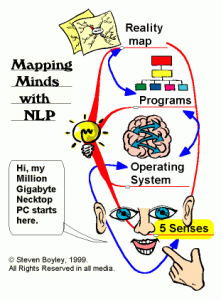 Neurolinguistic Programming (NLP) : NLP is a solution- or outcome-oriented technology. NLP focuses attention on what the desired state of being each client wishes to move toward, as opposed to re-examination of the past. It is often used in conjunction with EMDR and Energy Psychology techniques and is particularly concerned with speech patterns and self-limiting belief structures.
Neurolinguistic Programming (NLP) : NLP is a solution- or outcome-oriented technology. NLP focuses attention on what the desired state of being each client wishes to move toward, as opposed to re-examination of the past. It is often used in conjunction with EMDR and Energy Psychology techniques and is particularly concerned with speech patterns and self-limiting belief structures.
 Neurology, Neural Therapies : Although little known in the United States, neural therapy is widely practiced in Europe, especially Germany. It is a healing technique that involves injecting anesthetics at specific points in the body to relieve health problems. Neural therapy has been found especially useful in treating chronic pain.
Neurology, Neural Therapies : Although little known in the United States, neural therapy is widely practiced in Europe, especially Germany. It is a healing technique that involves injecting anesthetics at specific points in the body to relieve health problems. Neural therapy has been found especially useful in treating chronic pain.
 NMT (Neuromuscular Therapy) : The goal of Neuromuscular Therapy (NMT) is to harmonize the inseparable workings of the musculoskeletal systems and the nervous system. The technique involves alternating levels of pressure to active areas of the muscles. When the active area is released by the pressure, the energy of the body can flow normally. This reactivated normal flow of body energy improves pain symptoms. Factors of importance that the practitioner evaluates with a client are: ischemia; trigger points; nerve entrapment or compression; postural distortions; emotional status; nutrition.
NMT (Neuromuscular Therapy) : The goal of Neuromuscular Therapy (NMT) is to harmonize the inseparable workings of the musculoskeletal systems and the nervous system. The technique involves alternating levels of pressure to active areas of the muscles. When the active area is released by the pressure, the energy of the body can flow normally. This reactivated normal flow of body energy improves pain symptoms. Factors of importance that the practitioner evaluates with a client are: ischemia; trigger points; nerve entrapment or compression; postural distortions; emotional status; nutrition.
Nutritional Counseling : Healthful diets help people of all ages feel and perform their best. Our food choices can have a profound impact on well-being and longevity. Simply eating right is certainly a part of nutritional therapy, but there is more. With the luxury we now have of easily meeting our minimum requirements for most nutrients, we can begin to consume the optimal levels of healthful nutrients through food and supplements. Nutritional counseling is particularly helpful for disease prevention, but can also be utilized to facilitate recovery from diseases of nutritional and/or metabolic origin.
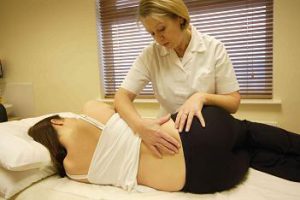 Osteopathy : Fundamental to the practice of many osteopathic physicians is the use of manual diagnosis and manipulative treatments based on the concept of the body as an interconnected system of nerves, muscles, and bones – all of which need to function as an integrated whole. Problems in the musculoskeletal system often affect the health of underlying organs. Doctors of Osteopathy (D.O.) are all trained to use osteopathic manipulations to release physical blockages to enable the body to regain its innate ability to heal itself.
Osteopathy : Fundamental to the practice of many osteopathic physicians is the use of manual diagnosis and manipulative treatments based on the concept of the body as an interconnected system of nerves, muscles, and bones – all of which need to function as an integrated whole. Problems in the musculoskeletal system often affect the health of underlying organs. Doctors of Osteopathy (D.O.) are all trained to use osteopathic manipulations to release physical blockages to enable the body to regain its innate ability to heal itself.
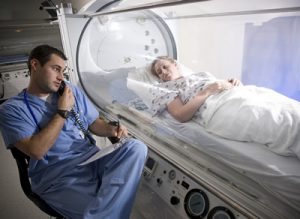 Oxygen Therapy-Medicine : Oxygen therapy involves the use of different forms of oxygen to promote healing by altering the body’s chemistry. There are several types of oxygen therapy: Oxygenation using hyperbaric (high-pressure) oxygen chambers; the addition of hydrogen peroxide or other compounds to capture electrons from foreign substances in the body in a natural process called oxidation; and ozone therapy, which aids in both oxidation and oxygenation.
Oxygen Therapy-Medicine : Oxygen therapy involves the use of different forms of oxygen to promote healing by altering the body’s chemistry. There are several types of oxygen therapy: Oxygenation using hyperbaric (high-pressure) oxygen chambers; the addition of hydrogen peroxide or other compounds to capture electrons from foreign substances in the body in a natural process called oxidation; and ozone therapy, which aids in both oxidation and oxygenation.
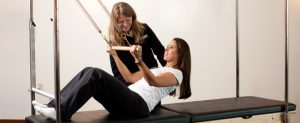 Pilates®-based Therapies : Joseph H. Pilates developed an exercise method over a span of 60 years. Utilizing both floor exercises and specialized equipment which he designed, the system involves strengthening individual muscles as well as balancing muscular force at the joint level. It focuses on core control, which is activation of the deep abdominal muscles, in particular, the transverses, to achieve a stabilized torso and pelvis, while performing a wide variety of movements. In physical therapy terms, this would be comparable to dynamic stabilization.
Pilates®-based Therapies : Joseph H. Pilates developed an exercise method over a span of 60 years. Utilizing both floor exercises and specialized equipment which he designed, the system involves strengthening individual muscles as well as balancing muscular force at the joint level. It focuses on core control, which is activation of the deep abdominal muscles, in particular, the transverses, to achieve a stabilized torso and pelvis, while performing a wide variety of movements. In physical therapy terms, this would be comparable to dynamic stabilization.
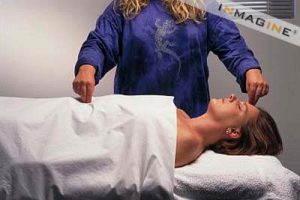 Polarity Therapy : Polarity Therapy is a comprehensive health system involving bodywork, diet, exercise, and self-awareness. This modality was founded in the 1940s by Randolph Stone. This health system utilizes the above listed therapies to rebalance the Human Energy Field which is the body’s subtle energy pattern.
Polarity Therapy : Polarity Therapy is a comprehensive health system involving bodywork, diet, exercise, and self-awareness. This modality was founded in the 1940s by Randolph Stone. This health system utilizes the above listed therapies to rebalance the Human Energy Field which is the body’s subtle energy pattern.
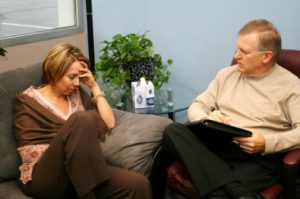 Psychology / Psychotherapy / Psychiatry : Psychotherapy today is as much about wholeness and wellness as it is about relieving psychological distress. At this time, there are many different approaches to psychotherapy ranging from traditional Freudian psychoanalysis, through art and music therapy, to transpersonal psychotherapy, which integrates the importance of spiritual experiences back into the study of the human condition. Psychiatry is the branch of the mental health field that prescribes medication – often synthetic, neurotoxic elements – for the suppression of emotional disturbances. As western medicine has worked to include a holistic approach to healing, the field of holistic psychiatry has developed. Holistic psychiatrists work to provide more than simple prescriptions for medications for their clients. These practitioners are returning to the roots of their profession and are focusing on developing a comprehensive routine of talk therapy, exercise, reflection, and meditation, in addition to medications.
Psychology / Psychotherapy / Psychiatry : Psychotherapy today is as much about wholeness and wellness as it is about relieving psychological distress. At this time, there are many different approaches to psychotherapy ranging from traditional Freudian psychoanalysis, through art and music therapy, to transpersonal psychotherapy, which integrates the importance of spiritual experiences back into the study of the human condition. Psychiatry is the branch of the mental health field that prescribes medication – often synthetic, neurotoxic elements – for the suppression of emotional disturbances. As western medicine has worked to include a holistic approach to healing, the field of holistic psychiatry has developed. Holistic psychiatrists work to provide more than simple prescriptions for medications for their clients. These practitioners are returning to the roots of their profession and are focusing on developing a comprehensive routine of talk therapy, exercise, reflection, and meditation, in addition to medications.
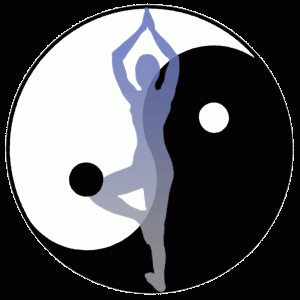 Qi Gong : A component of Traditional Chinese Medicine, qi gong (pronounced CHEE-GONG) has been practiced for several thousand years. Qi gong promotes health, longevity, and healing through exercises designed to circulate and balance qi, or vital energy, in the body.
Qi Gong : A component of Traditional Chinese Medicine, qi gong (pronounced CHEE-GONG) has been practiced for several thousand years. Qi gong promotes health, longevity, and healing through exercises designed to circulate and balance qi, or vital energy, in the body.
 Rebirthing : Rebirthing – and a related therapy called “Holotropic Breath work” – utilizes connective breath, creative thought, affirmations, and forgiveness to enhance aliveness and release subconscious thought patterns of struggle that were imprinted at birth and early childhood.
Rebirthing : Rebirthing – and a related therapy called “Holotropic Breath work” – utilizes connective breath, creative thought, affirmations, and forgiveness to enhance aliveness and release subconscious thought patterns of struggle that were imprinted at birth and early childhood.
 Reflexology : Reflexology is an ancient Oriental technique that enhances the flow of energy and circulation, and restores the harmony of our essence to the body, mind and spirit. The whole body is reflected in the feet, hands, and ears. According to Traditional Chinese Medicine theory base, the energy in these areas is tied to specific energy meridians and organs. As the practice developed in the United States, the areas of the feet, hands, ears were tied to neurological dermatomes for the theoretical explanation of reflexology function and effectiveness. With firm fingertip pressure application to the feet, hands, and ears, the energy pathways are unblocked and the body symptomatology resolves.
Reflexology : Reflexology is an ancient Oriental technique that enhances the flow of energy and circulation, and restores the harmony of our essence to the body, mind and spirit. The whole body is reflected in the feet, hands, and ears. According to Traditional Chinese Medicine theory base, the energy in these areas is tied to specific energy meridians and organs. As the practice developed in the United States, the areas of the feet, hands, ears were tied to neurological dermatomes for the theoretical explanation of reflexology function and effectiveness. With firm fingertip pressure application to the feet, hands, and ears, the energy pathways are unblocked and the body symptomatology resolves.
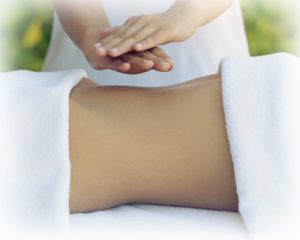
Reiki : Reiki (pronounced RAY-KEE) is a Japanese word that refers to the universal life force within all things. Reiki is a healing modality based on the unseen energy channels of the body (“chakras”). The practitioner places his or her hands on or above the client’s body with the intent to heal and energy flows, working to gently remove energy blockages and restore balance to the body’s energy system.
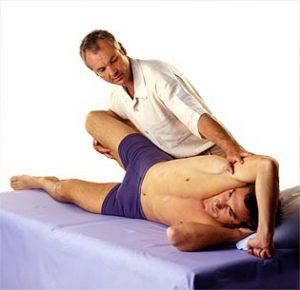 Rolfing : Rolfing is an original and scientifically validated system of body restructuring and movement education. It releases the body’s segments – legs, torso, arms, etc. – from lifelong patterns of tension and bracing, and permits gravity to realign them. By doing so, it balances the body. Because the body is better balanced after Rolfing, it expends less of its vital energies against gravity. This biological energy-efficiency is often experienced as a higher level of alertness and vitality. Movement becomes easier and overall personal functioning tends to improve.
Rolfing : Rolfing is an original and scientifically validated system of body restructuring and movement education. It releases the body’s segments – legs, torso, arms, etc. – from lifelong patterns of tension and bracing, and permits gravity to realign them. By doing so, it balances the body. Because the body is better balanced after Rolfing, it expends less of its vital energies against gravity. This biological energy-efficiency is often experienced as a higher level of alertness and vitality. Movement becomes easier and overall personal functioning tends to improve.
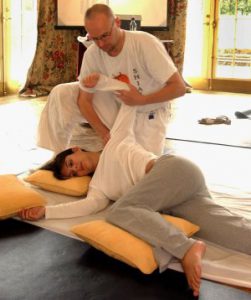 Shiatsu : Shiatsu involves applying pressure to meridian points to stimulate or sedate them. Practitioners generally treat the meridians of the entire body in an attempt to bring relaxation, harmony, and balance. Based on traditional oriental medicine theory, shiatsu was developed in Japan and has been used extensively in the United States for the past 20 years.
Shiatsu : Shiatsu involves applying pressure to meridian points to stimulate or sedate them. Practitioners generally treat the meridians of the entire body in an attempt to bring relaxation, harmony, and balance. Based on traditional oriental medicine theory, shiatsu was developed in Japan and has been used extensively in the United States for the past 20 years.
 Stress Reduction Therapy : Stress reduction is really the task of managing our stress levels. When stress becomes distress, do we have some ability to break the building cycle and stimulate the relaxation response? If we think of the hot buttons that create that miserable inner feeling we call stress, we usually see that they are outside our skin – money, time pressures, people wanting our attention, traffic, deadlines, etc. What lies inside our skin are the physiological and psychological reactions to the stressors. What is outside is often not totally within our ability to control, thus it becomes a threat to our inner calm and control. Practitioners/educators of stress reduction and management techniques are becoming increasingly easier to find.
Stress Reduction Therapy : Stress reduction is really the task of managing our stress levels. When stress becomes distress, do we have some ability to break the building cycle and stimulate the relaxation response? If we think of the hot buttons that create that miserable inner feeling we call stress, we usually see that they are outside our skin – money, time pressures, people wanting our attention, traffic, deadlines, etc. What lies inside our skin are the physiological and psychological reactions to the stressors. What is outside is often not totally within our ability to control, thus it becomes a threat to our inner calm and control. Practitioners/educators of stress reduction and management techniques are becoming increasingly easier to find.
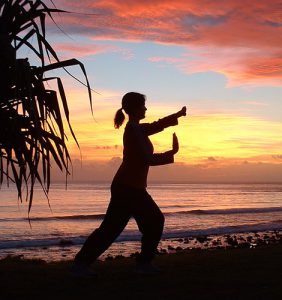 T’ai Chi : T’ai Chi is a Chinese Taoist martial art form of meditation in movement, combining mental concentration, coordinated breathing, and a series of slow, graceful body movements. T’ai Chi may be practiced for meditative and health purposes or, with increased speed, the movements may be used for self-defense. The practitioner allows the body weight or center of gravity to sink into the abdomen and feet. This relaxes and deepens the breathing, quiets the mind, and in turn, regulates the heartbeat, digestion, and various other muscular neurological, glandular, and organic functions.
T’ai Chi : T’ai Chi is a Chinese Taoist martial art form of meditation in movement, combining mental concentration, coordinated breathing, and a series of slow, graceful body movements. T’ai Chi may be practiced for meditative and health purposes or, with increased speed, the movements may be used for self-defense. The practitioner allows the body weight or center of gravity to sink into the abdomen and feet. This relaxes and deepens the breathing, quiets the mind, and in turn, regulates the heartbeat, digestion, and various other muscular neurological, glandular, and organic functions.
 Thought Field Therapy (TFT) : Thought Field Therapy (TFT), developed by Dr. Roger J. Callahan, is a revolutionary approach to the treatment of psychological and emotional disturbances. Similar to EFT (mentioned above), TFT is a form of Energy Psychology (see above), which generates results by manipulating the body’s subtle energies while tuning into an issue or problem.
Thought Field Therapy (TFT) : Thought Field Therapy (TFT), developed by Dr. Roger J. Callahan, is a revolutionary approach to the treatment of psychological and emotional disturbances. Similar to EFT (mentioned above), TFT is a form of Energy Psychology (see above), which generates results by manipulating the body’s subtle energies while tuning into an issue or problem.
Summary : Integrative Holistic Modalities consists of a rich array of techniques, modalities, and medical systems. Many of the alternative forms of treatment come to us from different cultures and ancient healing methods as well as those developed in the India. They help treat the root of the problem, boost the immune system, and help reinforce the body’s innate healing mechanisms.
Modern (allopathic) medicine is a very new discipline, unique to the 20th century and to western societies. The World Health Organization estimates that between 65-80 percent of the world’s population relies on traditional medicine as their primary form of health care.
There is a growing body of scientific evidence showing that many alternative therapies can be more effective, more economical, less harmful, and less invasive than orthodox medical treatments. Many medical doctors are starting to incorporate alternative treatments in their practice. Such practitioners are usually said to be practicing “integrative holistic medicine.”
